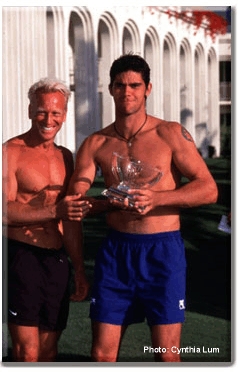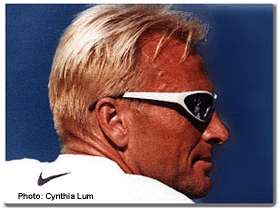Gavin Hopper: Coach of
Mark Philippoussis
When the young Australian Mark Philippoussis burst on the world tennis scene by blasting Pete Sampras off the court at the 1996 Australian Open, many observers predicted his rapid rise to the top of the pro game. But, despite his powerful, all court style and supersonic135 mph first serve, Philippoussis did not instantaneously meet the expectations created by the tennis media. Now more than 3 years later, Philippoussis appears more mature and more determined, and this is showing in his results, including a finals berth at the 1998 U.S. Open. His fitness and court coverage, obvious weaknesses in his game compared to the very top players, are vastly improved.
Philippoussis believes the change has resulted from a natural maturing process, but also from his work and physical training with Gavin Hopper, the Australian coach known most recently for turning Amanda Coetzer into the fittest player on the woman’s tour.
 |
Says Philippoussis of the changes he sees in himself: "There have been times in the past when I would have thought, today isn’t my day, don’t worry about it. I don’t think like that anymore, when it’s not your day, champions make it their day. I’ll go out there some days and I’m not playing good tennis, but I refuse to lose. I’m not going to get off that court unless I get that last point. That’s the way I’m thinking, and that’s the way it’s going to be."
TennisONE special contributing editor John Yandell noted first hand the growth in Philippoussis’s game, watching him work his way through the draw to win the 1999 Sybase Open in San Jose. During the tournament he had the opportunity to sit down for this interview with Hopper, a tour coach for 11 years, with a Phd in exercise physiology. Hopper, who has known Phillippoussis since he was 15, has worked with him full time for the last 2½ years.
T1: Australia has a long tradition going back to the days of (Davis Cup Captain) Harry Hopman of producing incredibly fit players. Talk a little bit about why that’s been the case.
GH: I think there are two reasons. First most Australians live around the coast. They grow up in an outdoor environment that promotes physical activity. Second as youngsters, they play rugby or Australian Rules football. Guys get into unbelievable condition. If you grow up in that environment, with that work ethic, it translates into other sports.
T1: What has your role has been in working with Mark.
GH: Mark Philippoussis doesn’t need a technical coach. He hits the ball as well as anyone in the game. The goal with Mark has been to take the fitness side out of the equation. Our idea was a long-term program: let’s get fit over 3 to 4 years. Over the last year, he’s lost 20 pounds.
T1: Watching Mark play here last year, his court movement didn't appear to be at the same level as the best players. This year it seems far better.
GH: You’re right, a year ago his movement wasn’t as good as the top players. Now that’s changed. He moves well enough to compete with anyone in the world.
T1: You’re known for your work as a conditioning coach for many top players. Talk about how you made the changes happen for Mark.
GH: Each player is very individual. Mark Philippoussis is at the other end of the spectrum from a player like Amanda Coetzer. It’s a matter of what a particular player needs and can tolerate.
T1: Obviously they play very different kinds of points—how is that reflected in the training?
GH: The players are so far apart that the whole approach is different. With Amanda, it was 3-4 hours on the court, all hitting balls, moving then another hour off court doing cardio and a weight session. With Mark its 1and ½ hours on court, working on the timing of his shots, since his points often last only 1 or 2 hits. Then working a half-hour off court. We do a lot stretching for injury prevention. He doesn’t need more power so we do circuit weights and free weights with low weights and high reps. Mainly we do shoulders and back. That’s also about injury prevention.
T1: Talk about the relationship between physical conditioning and the mental game.
 |
GH: No doubt every athlete feels the best when he or she is at a physical peak. That’s human nature more than anything else. When you feel good about yourself, you perform. The whole thing is a package. You can’t really put a percentage on structural changes, increased fitness and increased confidence.
T1: What has Pat Cash’s role been in working with Mark?
GH: We brought Pat on board to help Mark focus at the Slams. As a coach if I think other input can help us, I’m open. Pat has helped Mark understand that he should walk off the court mentally as well as physically fatigued. That’s the one area he needs most to improve. His mind tends to fluctuate during matches.
T1: It seems in the past Mark has had the tendency to get negative and down on himself.
GH: That’s the inability to stay focused. If you miss a shot, you go on to the next point.
T1: Watching him this year you get a different feeling, and the look in his eyes seems different.
GH: Right, he’s much better now at staying focused. In the last 6 to 9 months he’s made a big improvement in knowing who he really is.
T1: What about the expectations people have about Mark.
GH: Everyone knows Mark has the tools to be #1. Everyone around us expects it. Everyone is saying he’s not doing enough. He’s got to separate himself from those expectations. There is an expectation that if you never make it to #1—it almost looks like you’ve failed. Well, you haven’t failed, you may have had a great career.
Last Updated 5/1/99. To contact us, please email to: webmaster@tennisone.com
TennisONE is a registered trademark of TennisONE and SportsWeb ONE; Copyright 1995. All rights reserved.
